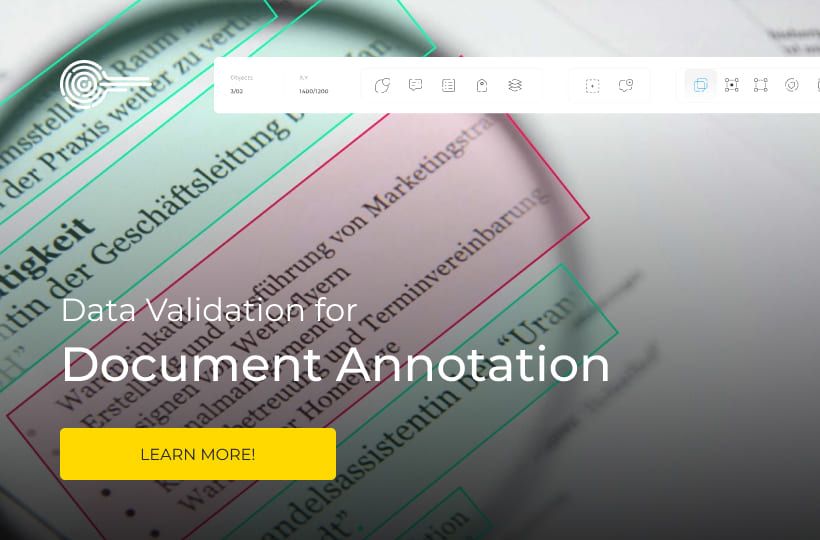Large Language Model Annotation: LLM Training Data
The development of large language models was made possible by high-quality datasets, as without them, it would be impossible to create tools that truly understand human language. In the LLM training process, the primary focus is on the structure and accuracy of the data. For this purpose, text annotation is employed, which provides a clear context and enables algorithms to interpret the input better. Therefore, the quality of language model data directly impacts the system's ability to generate logical and accurate answers.
Training models like GPT is not only about processing text arrays, but also about continually evaluating the LLM results and providing advice for their improvement. The GPT training process includes checking interpretations, detecting errors, and making changes at the semantic level.
Key takeaways
- Human validation remains crucial for handling ambiguous cases and edge scenarios.
- Modern workflows combine speed of automation with precision of expert analysis.
- Quality control mechanisms must evolve in tandem with model complexity.
- Effective labeling requires dynamic adaptation to changing project requirements.

Overview of AI training solutions
- Data collection and curation. Collecting and preparing diverse sources to create balanced sets of AI training data.
- Quality validation. Validating inputs and outputs to ensure consistency during LLM training.
- Instruction tuning. Tuning models based on hints and recommendations to improve the behavior of large language models.
- Feedback loops. Integrating user ratings and advice into the GPT training process to increase the practical value of the system.
A new approach to data annotation for AI
When working with language model data, context plays a crucial role in determining the model's accuracy in understanding the query. This approach to annotation forms the basis for effective natural language processing.
Manual verification remains indispensable for quality control, especially during GPT training. The integration of automatic tagging algorithms significantly speeds up the preparation of AI training data, allowing you to build scalable solutions for large language models without losing accuracy.
Importance of data annotation in Machine Learning
Without accurate and consistent AI training data, algorithms cannot understand context and may make errors even on simple tasks. For large language models, correct markup is the main thing they rely on when formulating input. When text annotation is done well, the model becomes able to give logical and understandable answers, rather than just repeating text.
In addition to basic tags, annotation includes labeling of entities, relationships, and instructions, which allows the model to learn the correct context. During GPT training, this helps the system not just generate text, but also understand what the user wants. The more accurate and detailed the markup, the more reliable the results will be.
Challenges in the LLM data annotation landscape
- High data volume. Large language models require thousands and millions of examples, and it is almost impossible to process them manually.
- Markup quality and consistency. Incorrect or inconsistent text annotation can lead to model errors and inaccurate answers.
- Language context and nuances. Models need to understand hidden meaning, sarcasm, or cultural nuances, and this isn't easy to convey through markup.
- Balance between automation and human expertise. Too much automation can reduce accuracy, and manual verification takes time and resources.
- Handling rare or specialized cases. Specific terminology or non-standard constructions require extra attention, and errors in these areas can significantly impact the result.
- Ethical and biased data. Even a slight bias in AI training data can compromise the model's performance and reputation.
The complexity of human judgment
Machines are good at counting and organizing, but they don't pick up on sarcasm, double meanings, or subtle nuances. So, when an expert tags or comments a text annotation, it's more than just "right or wrong"; it's a small decision that can significantly impact the model's behavior. Input errors are amplified in the output, resulting in a strange outcome.
Human judgment allows us to notice the invisible things: biases, ambiguities, and strange word associations. During GPT training, these minor edits often save the day because an automatic algorithm would miss them. By adding their experience, context, and a bit of intuition, annotators bring AI training data to life, not just dry statistics.

Integrating automation with expert human review
During LLM training, algorithms quickly sort, classify, and extract patterns, while an annotator checks for complex cases, adds context, and corrects errors. The combination of automated processes and manual verification helps to avoid biases and mistakes in GPT training. The algorithm handles routine tasks, while experts focus on critical points and complex examples. This makes generative AI more flexible and accurate in dealing with real-world queries.
Balancing Cost and Quality in Annotation
- Data volume vs. budget. Large AI training datasets are expensive, so you need to decide which examples are critical and which can be processed more quickly.
- Automation and quality control. Automated tools reduce costs, but without manual verification, the accuracy of text annotation decreases.
- Complex case prioritization. Rare or complex examples require more resources, but they affect the quality of the model in real-world queries.
- Annotation flexibility. Not all parts of the data require the same level of detail; intelligent allocation of resources helps maintain a balance between cost and performance.
- Validation and feedback. Investments in quality control and re-validation justify themselves because they ensure that LLM training produces accurate and reliable results.
The Role of RLHF in Enhancing Outputs
Reinforcement learning with human feedback, or RLHF, helps a model go beyond simply repeating text and produce practical and accurate answers. During LLM training, experts evaluate the model's output, flag the best options, and provide advice that is then used for training. Without RLHF, a model may produce logical but not entirely practical or desirable results.
Even more interestingly, RLHF not only improves accuracy but also helps reduce bias and incorrect responses. Human feedback tells the model what to consider acceptable and what not, and guides it towards more "human" behavior. Without it, it isn't easy to get consistently high-quality outputs, even if the data is perfectly labeled.
Summary
Data quality is everything. Without proper text annotation, even the most powerful large language models will get lost in context, producing strange or unhelpful results. Working with AI training data is a combination of automation and human judgment.
Every step, from data collection to output evaluation, forms the foundation for practical generative AI. The complexity of human judgment, the integration of automation with expert review, and the right strategy for balancing cost and quality allow you to create models that actually work in the real world.
FAQ
Why is high-quality data annotation critical for LLMs?
High-quality text annotation provides the model with clear context and structure, which is essential for large language models to interpret prompts correctly. This directly affects the accuracy and usefulness of the outputs.
What is LLM training, and how is it related to data?
LLM training is the process of teaching a large language model using text data. The outcome depends on how accurately and consistently the data is annotated.
How does automation help in data annotation?
Automated tools accelerate the process of labeling and sorting large text volumes, but they often overlook nuances and context. Human oversight is essential to ensure quality.
What role does human judgment play?
Annotators notice subtleties, biases, and rare cases that machines would miss. They add context that makes AI training data more practical and understandable for the model.
What is RLHF and why is it important?
Reinforcement Learning from Human Feedback (RLHF) enables the model to learn from human evaluations, thereby improving the accuracy and naturalness of its outputs. This allows the model to produce more accurate and predictable results.
What are the main challenges in LLM data annotation?
High data volumes, balancing automation with manual review, contextual nuances, biases, and rare or complex cases all make annotation a challenging process.
How do automation and expert review work together?
Algorithms handle routine tasks quickly, while experts focus on complex or rare cases. This hybrid approach ensures both speed and precision in LLM training.
What is the impact of data quality on model performance?
Inconsistent or incorrect annotations lead to inaccurate results, whereas well-annotated data enhances the model's ability to comprehend context and generate useful outputs.
Why is data annotation critical for generative AI?
For generative models, not only the quantity but also the accuracy, context, and nuances of the data matter. Proper annotation allows the model to generate clear, practical, and predictable results.
